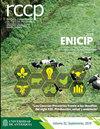绵羊产仔数的贝叶斯阈值分析
IF 0.5
4区 农林科学
Q4 AGRICULTURE, DAIRY & ANIMAL SCIENCE
引用次数: 0
摘要
32背景:出生时产仔数(LSB)是绵羊最重要的经济性状之一33,可用于肉类生产的遗传改良计划。LSB本质上是一个34分类特征,应该用阈值模型进行分析。目的:采用贝叶斯阈值35模型对绵羊LSB进行分析,估计遗传参数。方法:数据来自1986年至2012年在伊朗37个马库伊绵羊繁殖站收集的14968只母羊和682只父系的7901份LSB记录。估计LSB的38个遗传参数的后验分布均值(MPD),并使用偏差39信息准则选择最佳拟合模型。结果:在重复测量分析中,根据最佳拟合41,估计的直接遗传力和40个母体遗传力以及永久环境影响(±SE)接收时间:2021年2月9日;接受日期:2021年12月1日通讯作者。伊朗亚苏伊。邮政信箱:75914,传真:+98 741 222 4840,电话:+98 742 222 4840。电子邮件:mghaderi@yu.ac.ir,mosmos741@yahoo.com这部作品是根据知识共享署名非商业共享4.0国际许可证授权的。模型(模型5)分别为0.01(0.010)、0.02(0.014)和0.01(0.011)。在42项单变量分析中,直接遗传力和母体遗传力的最佳估计值分别为0.12(0.064)和43.08(0.045)。在第二胎次中,直接遗传力和母体遗传力呈增加趋势44(分别为0.15(0.082)和0.25(0.083))。在双变量分析中,LSB的直接遗传力和母体遗传力的45个最佳估计值分别为0.03(0.027)和0.22(0.041),46。母系和母系间的直接遗传相关性分别为0.25(0.054)和47.0.12(0.021)。结论:48个环境因素对每产绵羊LSB的影响较大;此外,从一个产次到另一个产代,获得了统计学上不同的遗传49个参数(p<0.05),表明遗传和环境因素对绵羊每个产次的影响不同且很大。51 52本文章由计算机程序翻译,如有差异,请以英文原文为准。
Bayesian threshold analysis of litter size in sheep
32 Background: Litter size at Birth (LSB) is one of the most important economic traits in sheep 33 and could be used in genetic improvement schemes for meat production. LSB is inherently a 34 categorical trait and should be analysed with threshold models. Objective: Bayesian threshold 35 models were used to analyze sheep LSB to estimate genetic parameters. Methods: Data was 36 based on 7,901 LSB records from 14,968 dams and 682 sires collected from 1986 to 2012 at 37 Makouie Sheep Breeding Station in Iran. Means of posterior distributions (MPDs) of LSB's 38 genetic parameters were estimated, and the best-fitted models were selected using the deviance 39 information criterion. Results: In the repeated measurement analyses, the estimated direct and 40 maternal heritabilities, and permanent environmental effect (±SE), according to the best-fitted 41 Received: February 9, 2021; accepted: December 1, 2021 Corresponding Author. Yasouj, Iran.P. O. Box: 75914,Fax: +98 741 222 4840, Tel: +98 741 222 4840. Email: mghaderi@yu.ac.ir, mosmos741@yahoo.com This work is licensed under a Creative Commons Attribution-NonCommercial-ShareAlike 4.0 International License. model (model 5), were 0.01 (0.010), 0.02 (0.014), and 0.01 (0.011), respectively. In the 42 univariate analysis, the best estimates of direct and maternal heritabilities were 0.12 (0.064) and 43 0.08 (0.045), respectively. An increasing trend for direct and maternal heritabilities was 44 observed in parity 2 (0.15 (0.082) and 0.25 (0.083), respectively). In the bivariate analysis, the 45 best estimates of direct and maternal heritabilities for LSB were 0.03 (0.027) and 0.22 (0.041), 46 respectively. The direct and maternal genetic correlations among parities were 0.25 (0.054) and 47 0.12 (0.021), respectively. Conclusions: The results showed a considerable influence of 48 environmental factors on LSB in each parity of sheep; also, statistically different genetic 49 parameters (p<0.05) were obtained from one parity to another, indicating the different and large 50 influences of genetic and environmental factors for each parity in sheep. 51 52
求助全文
通过发布文献求助,成功后即可免费获取论文全文。
去求助
来源期刊

Revista Colombiana De Ciencias Pecuarias
AGRICULTURE, DAIRY & ANIMAL SCIENCE-
CiteScore
0.80
自引率
0.00%
发文量
18
审稿时长
6-12 weeks
期刊介绍:
The editors of Revista Colombiana de Ciencias Pecuarias (RCCP) welcome the submission of original manuscripts on experimental and clinical studies associated with the broad areas of animal sciences and veterinary medicine as they interface with biochemistry, molecular biology, physiology, pharmacology, toxicology, pathology, microbiology, parasitology, immunology and epidemiology. The scope of the journal includes studies of basic and applied research in animal management and production, feeding and nutrition, reproduction, breeding, genetics, animal welfare and behavior; as well as animal production focussed from biotechnology, soil science, agrostology, silvopastoral systems, livestock economics and the environment.
The criteria for acceptance of papers submitted for publication are originality, quality and clarity of the content. Each contribution must be based on original, unpublished research that has not been simultaneously submitted to other journals. All papers will be peer reviewed. All authors bear responsibility for ensuring the integrity and quality of their reported research. It is the author''s responsibility to secure permission to use figures or tables that have been published elsewhere.
Contributions may be classified as original research, review, rapid communication, clinical case studies or methodological articles, as well as news/commentaries or letters to the editor. Most review articles are invited by the editor. Authors interested in submitting a review article should contact the corresponding editor. Rapid publication of original manuscripts is a goal of the journal. Manuscripts must be written in English. Each manuscript is considered for publication with the understanding that it has not been simultaneously submitted to any other journal. Upon acceptance for publication, papers are subject to editorial review and revision.
 求助内容:
求助内容: 应助结果提醒方式:
应助结果提醒方式:


